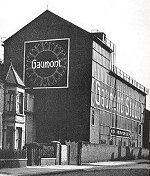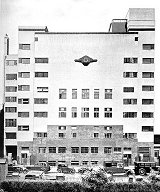Alfred Bromhead (called A. C.) had been
the assistant of John Le Coutour who was the agent for Gaumont films and
Demeny film equipment from France in 1897 under the company name of L. Gaumont
et Cie. Le Coutour was more interested in experimenting with paper films
trying to develop his Photographic Association of which he was the founder..
So he was dismissed by Gaumont.
A. C. was asked to become the new agent
for Gaumont so A. C. formed the Gaumont Company in 1898 with his younger
brother Reginald. A. C. set up offices at 25 Cecil Court in London. The
Gaumont Company quickly became successful and he expanded into handling
films for Hepworth,
Elge (France) and Lumiere (France).
Business was booming so in 1903, A. C.'s
other younger brother Herbert also joined the company.
AS A SIDE NOTE:
Gaumont was also the British distributor for Solax.
 In
1912, A. C. wanted to move more into production so they built a studio called
Lime Grove in Shepherd's Bush. The studio primarily produced actualities
and cartoons. The project was successful enough that in 1915, A. C. bought
additional property adjacent to the studio and expanded the facilities.
With the new expansion, the decision was made to move more into feature
films. Shown on the left is the studio in 1914.
In
1912, A. C. wanted to move more into production so they built a studio called
Lime Grove in Shepherd's Bush. The studio primarily produced actualities
and cartoons. The project was successful enough that in 1915, A. C. bought
additional property adjacent to the studio and expanded the facilities.
With the new expansion, the decision was made to move more into feature
films. Shown on the left is the studio in 1914.
AS A SIDE NOTE:
During the First World War A. C. Bromhead attained the rank of Lieut.-Colonel
and commanded special missions to Russia and Italy, for which he was awarded
the CBE in 1918.
After the war, the studio struggled to regroup
from the lack of actors and technicians. They brought in Thomas Welsh as
General Manager who in turn brought in George Pearson as director. This
only lasted for a short time because Welsh and Pearson left to form the
Welsh-Pearson Film Company and set up their own studio in Craven
Park.
In 1922, the Bromhead brothers bought out
Gaumont's interest in the company and changed the name to Gaumont-British
Pictures Corp.
In 1926, the Bromhead brothers decided that
it was time to expand again. They received backing from the Ostrer brothers
and did a £2,500,000 expansion. On their board, they added Simon Rowson
from Ideal Productions and C. M Woolf from W&F Film Service. This surrounded
the studio with needed services.
In 1928, Gaumont absorbed Gainsborough Pictures
headed by Michael Balcon and formed a conglomerate which also included nearly
300 cinemas. Balcon remained head of production for the Gainsborough studio
in Islington.
In 1929, A. C. retired and turned control
of the studios over to the 5 Ostrer brothers. Isadore Ostrer became President,
Mark Ostrer became Chairman, David (the oldest) became head over International
Sales, Maurice became director and Executive Producer and Harry (the youngest
and ex-school teacher) became head of the Script Department.
With the advent of sound, the Ostrer brothers
set out to renovate the Lime Grove studio with sound systems. While the renovations were being made, Gainsborough Studios at
Islington was used as the production arm with Michael Balcon operating at
both facilities. Shown to the right is the newly renovated Lime Grove studio.
systems. While the renovations were being made, Gainsborough Studios at
Islington was used as the production arm with Michael Balcon operating at
both facilities. Shown to the right is the newly renovated Lime Grove studio.
Gaumont established an alliance with Ufa
of Germany and started work on British version of several major Ufa films.
Unfortunately, this alliance ceased abruptly when Hitler took control of
the country in the early 1930s.
In 1936, Balcon who was increasingly having trouble
with management, left Gainsborough for a 2 year contract with MGM for a
larger salary. Ted Black took over production at Islington.
In 1937, with the British market shrinking, Isadore
Ostrer announced that Lime Grove would have to close down. C. M. Woolf and
J. Arthur Rank came in
with a package to take over the production of Lime Grove and move it to
Pinewood and let Gainsborough continue its production. This package
would slowly move ownership to Rank.
Ironically, Pinewood closed down the following year
and Islington received a new burst of life from a contract with 20th
Century Fox. Unfortunately, 1939 brought World War II and a lot of changes.
Another odd twist came when the chimneys at Islington
became unstable and Lime Grove had to be reopened to take care of the production.
In 1941, Rank took control of Gaumont and shortly
afterward Isadore Ostrer died the same year. The following year C. M. Woolf
also died.
With Maurice Ostrer and Ted Black at the controls
of the production and 20th Century contracts expiring in 1942, Black gambled
that what Britain needed was some escapism films to get the publics mind
off of the war. These became the most successful films in Lime Grove history,
fueling a feud between Ostrer and Black. Black left Gaumont to join Korda
at MGM.
At the end of the war, Rank, unhappy with Ostrer handling
of production replaced him with Sidney Box. Several well accepted films
were made but by 1949 the heavy overhead of the outdated facilities were
too much. Rank liquidated Gainsborough and Gaumont. The Lime Grove Studio
was sold to BBC television.
Back to British
Studios



